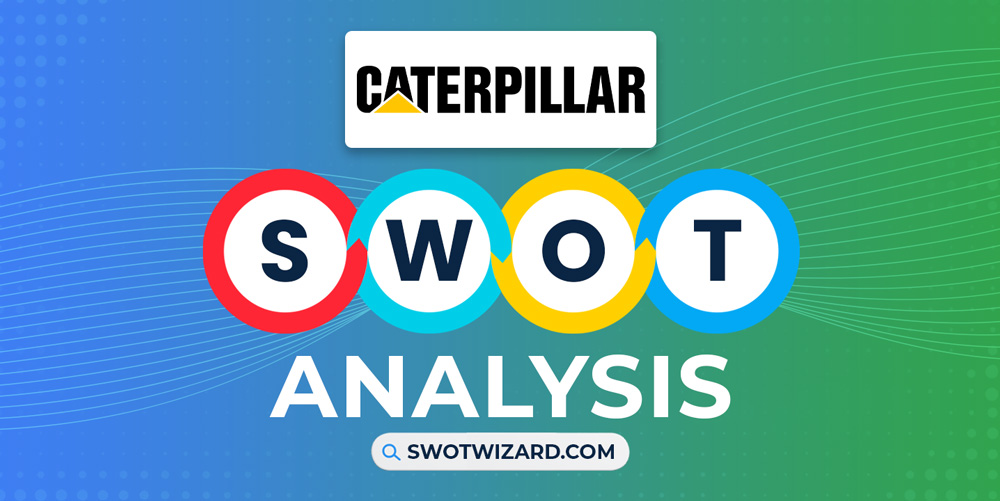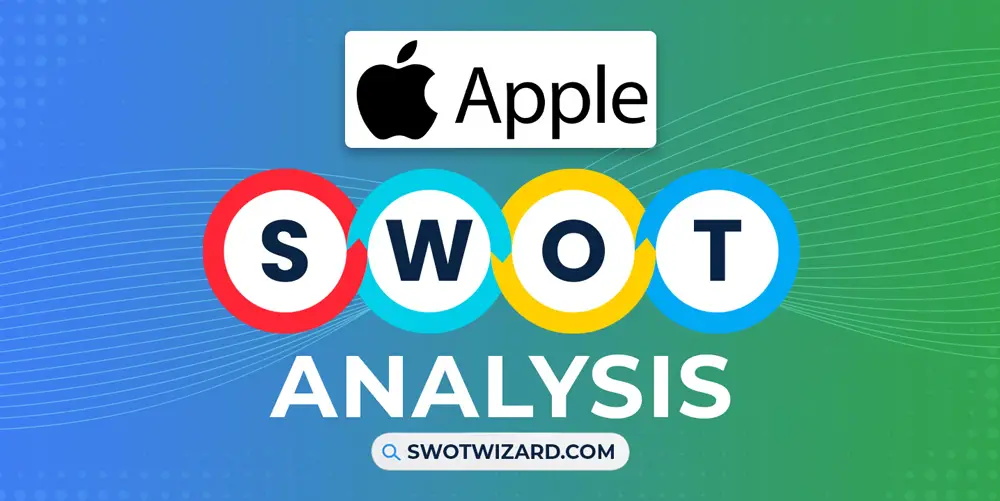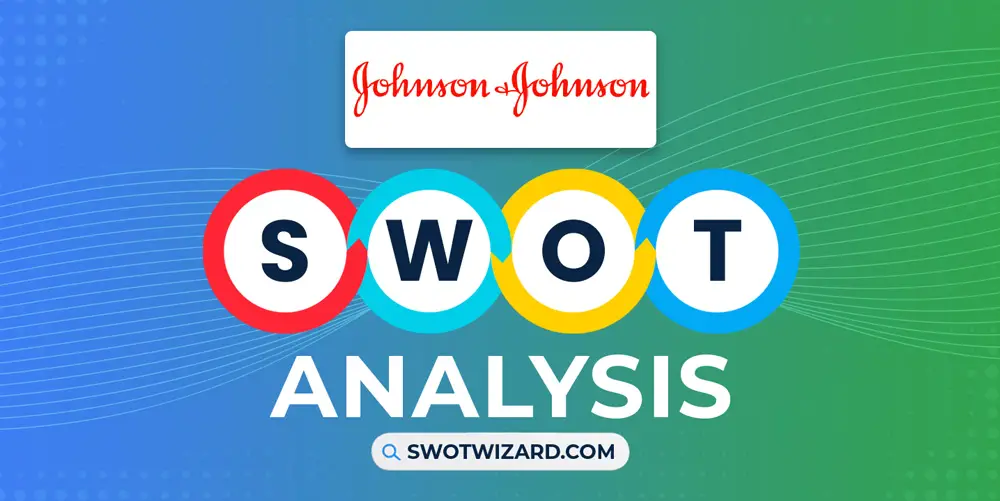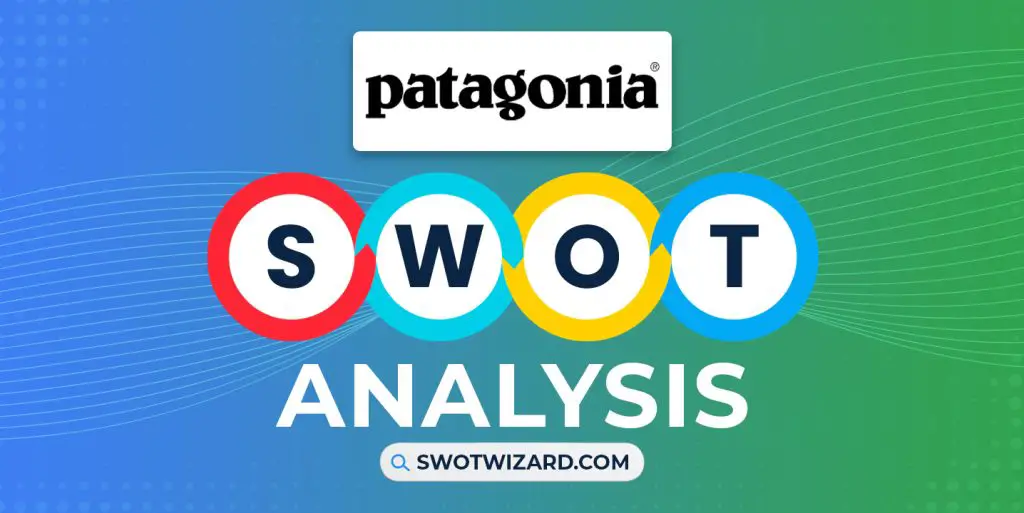Caterpillar has reached every corner worldwide, whether coal mining in a remote area or a small house project in a third-world country. With hundred years of innovation and constant offerings, the company has touched a new height which we will learn in this Caterpillar swot analysis.
Caterpillar: Company Overview
| Company | Caterpillar Inc. |
| Industry | Heavy equipment |
| Founded | 15 April, 1925 |
| Founders | C.L. Best, Benjamin Holt |
| CEO | Jim Umpleby |
| Headquarter | Irving, Texas, U.S. |
| No. of Employees | 109,100+ |
| Annual Revenue | $59.4 billion (FY 2022) |
| Website | caterpillar.com |
Caterpillar is approaching their centenary in the next two years, as the company was founded in 1925 and resulted from a merger of two companies with rich histories. And now, it has become one of the world’s leading construction and mining equipment manufacturers.
Even NASA used Caterpillar components in the design of the Space Shuttle’s crawler-transporter, which was responsible for moving the space shuttle to and from the launch pad.
With a workforce that spans the globe, Caterpillar employs over 109,100 dedicated individuals and achieved total revenue of $59.427B in 2022, a testament to its industry-leading position.
Product & Services of Caterpillar
Bulldozer | Excavator | Wheel Loader | Haul Truck | Diesel/Gasoline Engine
Caterpillar Competitors
John Deere | Volvo Construction Equipment | Komatsu | JCB | SANY | XCMG | Terex Corporation | Liebherr Group | Hitachi Construction Machinery | CNH Industrial
Did You Know?
Caterpillar manufactures the largest bulldozer in the world, known as the D11 series, which weighs over 230,000 pounds and is used for heavy-duty earthmoving and construction projects.
Strengths – Caterpillar SWOT Analysis
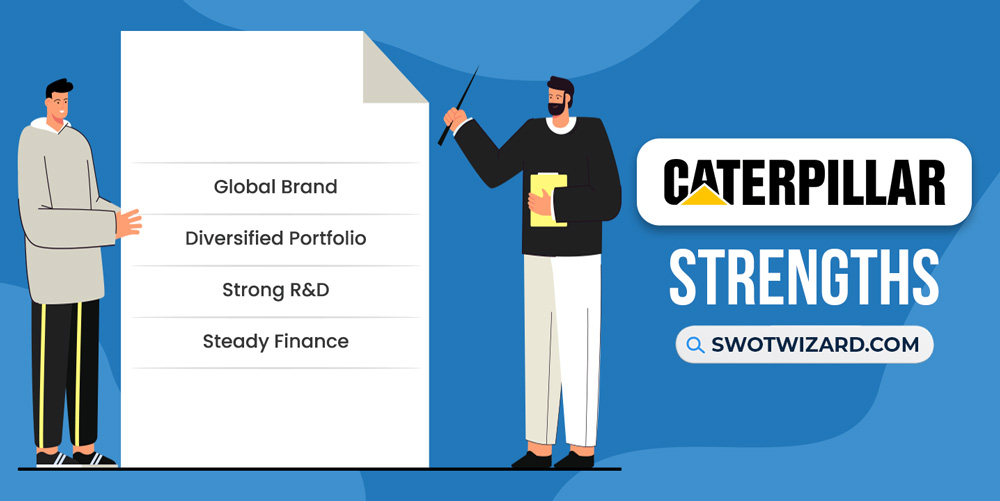
Global Brand: The company’s reputation has allowed it to expand into new markets and gain customers’ trust worldwide, recognized for its quality and reliability. As a result, the company’s brand value was estimated at $7,397M in 2022. Besides, their brand reputation has helped secure a significant contract with the Indian government to supply construction equipment.
Diversified Portfolio: Diversification minimizes a company’s dependence on any single market sector, and Caterpillar maintain an extensive and diversified portfolio, encompassing a wide range of products serving multiple industries. They have 20 brands in their portfolio, which says a lot about their diversification.
Strong R&D: Without digital and standardized R&D, a company like Caterpillar can’t become this big. The company’s commitment to research and development (R&D) has resulted in technological advancements and innovative products. As per the data, the company invested $1.814B in R&D in 2022, fostering the development of fuel-efficient engines, advanced automation systems, and digital solutions.
Steady Finance: Characterized by steady cash flow and net income, Caterpillar maintains a strong financial position. The company generated $59.427B in sales and achieved a net profit of $6.705B in 2022. Besides, its strong credit rating, which is A+, provides access to favorable financing terms, facilitating future growth and acquisitions.
Weaknesses – Caterpillar SWOT Analysis
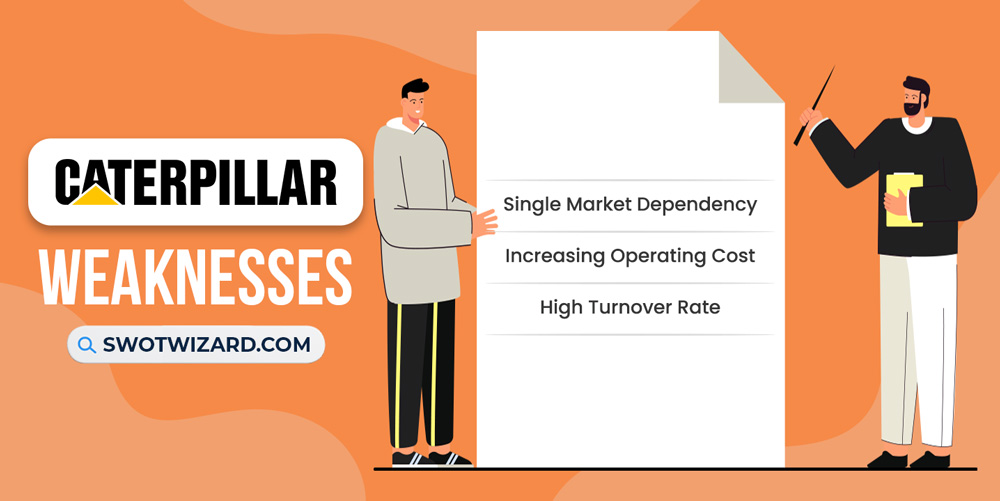
Single Market Dependency: The company’s biggest revenue category source is the construction and mining industry, and as for the geographic area, North America and the USA hold the major portion of the revenue, which is over 70%. As a result, due to various reasons, whether it’s economic recession or geopolitical issues, the company’s revenue is at risk and heavily relies on a few pillars.
Increasing Operating Cost: Due to various reasons, like the rising cost of raw materials, labor, war, energy expenses, etc., Caterpillar faces the challenge of rising operating costs. Last year, due to the Russia-Ukrain war, the overall operating expense hit the ceiling as steel prices skyrocketed and hurt the company’s profit margins.
High Turnover Rate: Caterpillar has been grappling with a relatively high employee turnover rate, leading to increased recruitment and training costs and a loss of valuable institutional knowledge. Data says that the average turnover rate in Caterpillar’s all divisions was 38%, significantly higher than the industry average of 10% in 2022.
Opportunities – Caterpillar SWOT Analysis

Market Expansion: With a growing demand for infrastructure development, the company has enough opportunities to expand. A study shows that the global construction market is expected to reach $15.5 trillion by 2030, driven by urbanization and infrastructure development in emerging markets.
Renewable Energy: The global shift towards renewable energy sources creates opportunities for Caterpillar to provide equipment and solutions for the renewable energy sector. The renewable energy sector is projected to grow at a CAGR of 16.9% from 2022 to 2030, enough opportunities for the company to develop and market power generation systems utilizing renewable sources like solar and wind energy.
New Tech: The world is moving toward more and more technology, and investing in emerging technologies like automation, electrification, and data analytics can enable Caterpillar to offer advanced and efficient solutions. Besides, pursuing sustainability with new tech will give the company a new edge.
Effective Acquisition: Strategic acquisitions can provide Caterpillar access to new markets, technologies, and customer segments. As a part of the plan, Caterpillar’s acquisition of Weir Oil & Gas in 2021 expanded its offerings in the oil and gas industry, enabling the company to serve a broader customer base and enhance its market position. And so far, the company has invested in 33 acquisitions worldwide.
Threats – Caterpillar SWOT Analysis
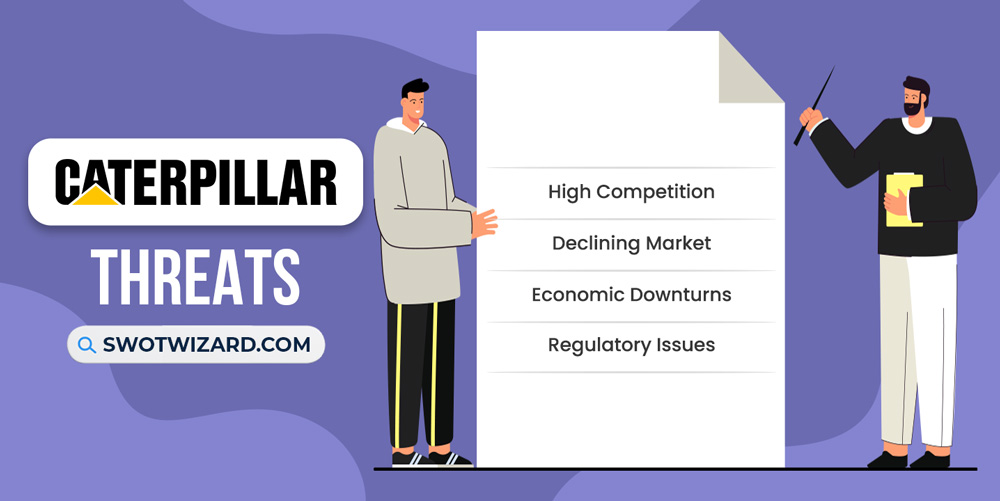
High Competition: Even for a market leader, competition has been an issue, and with globalization and availability, Caterpillar faces intense competition from established players and emerging competitors in the construction and mining equipment industry. The biggest competitor, Komatsu, a major competitor, offers similar product lines and has a strong presence in key markets, challenging Caterpillar’s market share.
Declining Market: The construction and mining equipment market is subject to fluctuations influenced by factors such as infrastructure spending, commodity prices, and geopolitical uncertainties. A slowdown in construction activity due to reduced government investments or economic uncertainties can lead to decreased demand for Caterpillar’s products.
Economic Downturns: Caterpillar’s business is vulnerable to economic downturns and recessions. Construction projects are often delayed or canceled during such periods, reducing equipment demand, as in 2009, when Caterpillar’s sales declined by 22% due to the global financial crisis.
Regulatory Issues: The regulatory environment poses challenges for Caterpillar. Compliance with emissions standards, safety regulations, and environmental policies requires significant investments in research and development. Regulation changes like stricter emission standards can increase costs and disrupt the company’s operations.
[Bonus Infographic] SWOT Analysis of Caterpillar
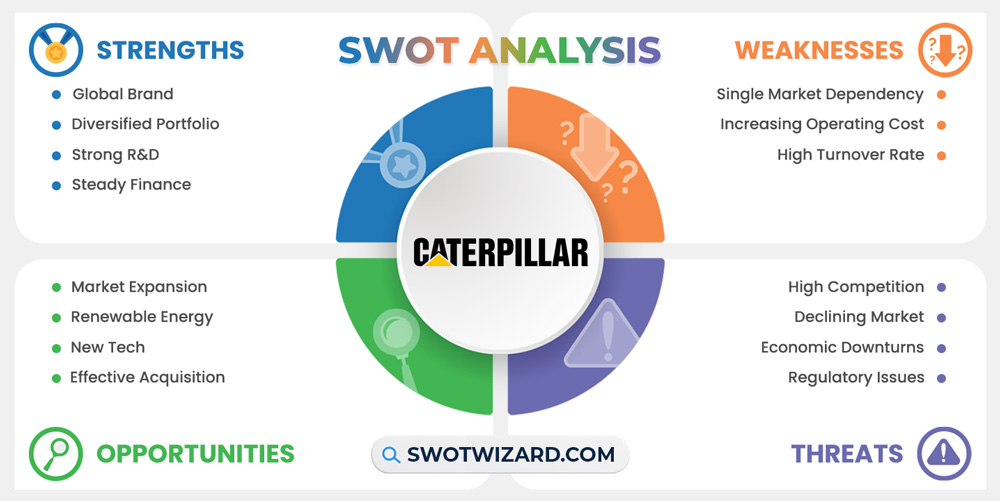
Recommendations for Caterpillar
With the market declining and tons of issues rising daily, the company needs to plan the future strategically. As for that, here are some recommendations.
- Explore untapped markets and regions to diversify revenue streams and reduce dependence on specific industries or regions.
- Invest in and develop sustainable technologies and products, such as electric or hybrid equipment, to meet the growing demand for environmentally friendly solutions.
- Emphasize digitalization, automation, and connectivity for enhancing productivity, efficiency, and the customer experience.
- Identify potential acquisition targets to strengthen product offerings, expand customer base, and gain a competitive edge.
- Stay ahead of changing regulations by actively engaging with policymakers, investing in emission-reduction technologies, and ensuring safety and environmental standards compliance.
Frequently Asked Questions (FAQs)
Who is the world’s largest Caterpillar dealer?
Finning is the world's largest Caterpillar dealer.
Is Caterpillar a Fortune 500 company?
Yes, Caterpillar is a Fortune 500 company.
Final Words on Caterpillar SWOT Analysis
Caterpillar possesses a strong brand, extensive product portfolio, and global presence. However, it faces challenges from high competition, market fluctuations, economic downturns, and regulatory issues. Caterpillar can maintain its competitive position and drive future growth by strategically expanding markets, embracing renewable energy and new technologies, and effectively navigating regulatory landscapes.
References
- Wikipedia contributors. (n.d.). Caterpillar. Wikipedia.
- Construction equipment maker Caterpillar boosts India presence with two new launches. (2022, May 19). The Economic Times.
- Ghosh, A., & Jain, D. (2022, August 2). Wall Street falls on rising US-China tensions, Caterpillar shares weigh. Mint.
- Gordon, P. (2009, January 26). Caterpillar has recorCaterpillar has record profits but faces it most challenging year in decadesd profits but faces it most challenging year in decades. Holland Sentinel.

